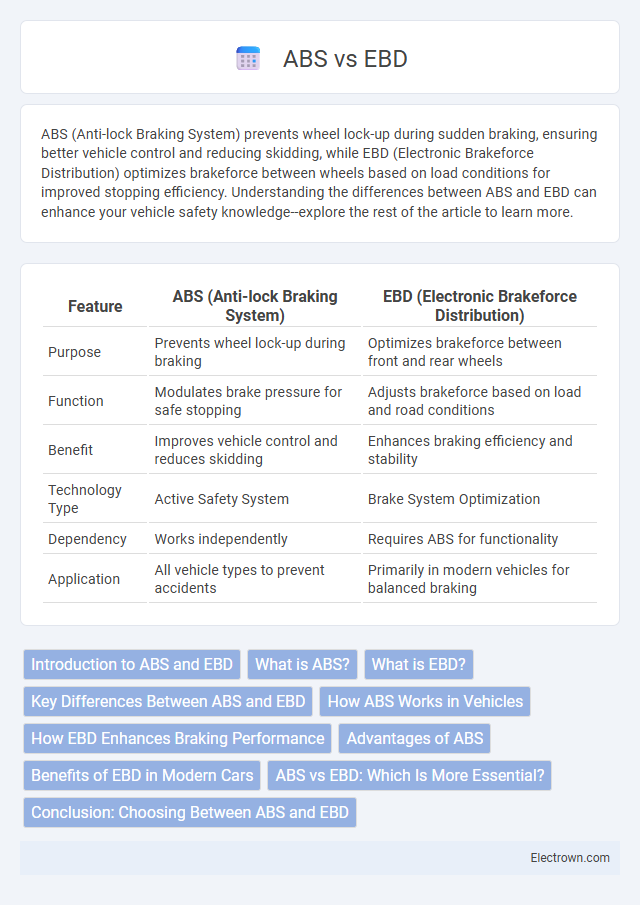ABS (Anti-lock Braking System) prevents wheel lock-up during sudden braking, ensuring better vehicle control and reducing skidding, while EBD (Electronic Brakeforce Distribution) optimizes brakeforce between wheels based on load conditions for improved stopping efficiency. Understanding the differences between ABS and EBD can enhance your vehicle safety knowledge--explore the rest of the article to learn more.
Table of Comparison
| Feature | ABS (Anti-lock Braking System) | EBD (Electronic Brakeforce Distribution) |
|---|---|---|
| Purpose | Prevents wheel lock-up during braking | Optimizes brakeforce between front and rear wheels |
| Function | Modulates brake pressure for safe stopping | Adjusts brakeforce based on load and road conditions |
| Benefit | Improves vehicle control and reduces skidding | Enhances braking efficiency and stability |
| Technology Type | Active Safety System | Brake System Optimization |
| Dependency | Works independently | Requires ABS for functionality |
| Application | All vehicle types to prevent accidents | Primarily in modern vehicles for balanced braking |
Introduction to ABS and EBD
Anti-lock Braking System (ABS) prevents wheel lock-up during sudden braking by modulating brake pressure, enhancing vehicle control and reducing skidding risk. Electronic Brakeforce Distribution (EBD) optimizes brake force between front and rear wheels based on load conditions, improving stability and stopping efficiency. Understanding how ABS and EBD work together helps your vehicle maintain traction and balance under various driving situations.
What is ABS?
ABS, or Anti-lock Braking System, enhances vehicle safety by preventing wheel lock-up during sudden braking, thereby maintaining traction and steering control. It works through sensors that monitor wheel speed and modulate brake pressure to avoid skidding. This technology significantly reduces stopping distances on slippery surfaces and improves overall braking performance.
What is EBD?
EBD, or Electronic Brakeforce Distribution, is a technology that adjusts the braking pressure applied to each wheel based on factors such as load, road conditions, and vehicle speed. It works in conjunction with ABS (Anti-lock Braking System) to optimize braking efficiency and enhance vehicle stability during sudden stops or emergency braking situations. Your vehicle's EBD system ensures balanced brake force, reducing the risk of wheel lockup and improving overall stopping performance.
Key Differences Between ABS and EBD
ABS (Anti-lock Braking System) prevents your wheels from locking during sudden braking, enabling better steering control, while EBD (Electronic Brakeforce Distribution) automatically adjusts the brake force to each wheel based on load conditions for optimal stopping performance. ABS primarily enhances vehicle stability and steering, whereas EBD optimizes braking efficiency by distributing pressure between front and rear brakes. Understanding these distinctions helps improve your vehicle's safety by combining both systems for maximum control and braking effectiveness.
How ABS Works in Vehicles
Anti-lock Braking System (ABS) prevents wheel lockup during emergency braking by rapidly modulating brake pressure through electronic control units and hydraulic valves, maintaining tire traction on various road surfaces. This system employs wheel speed sensors to monitor each wheel's rotational speed, allowing the ABS to adjust braking force and enable better steering control. By preventing skidding, ABS enhances vehicle stability and reduces stopping distances in critical scenarios.
How EBD Enhances Braking Performance
Electronic Brakeforce Distribution (EBD) enhances braking performance by intelligently modulating brake pressure between the front and rear wheels based on load conditions, ensuring optimal stopping power and vehicle stability. Unlike Anti-lock Braking System (ABS), which prevents wheel lock-up, EBD maximizes braking efficiency by adapting brake force for varying weight distribution during deceleration. This dynamic adjustment reduces stopping distances and improves control, especially under uneven road surfaces or during emergency braking scenarios.
Advantages of ABS
Anti-lock Braking System (ABS) enhances vehicle safety by preventing wheel lock-up during sudden braking, maintaining steering control and reducing skidding risks. ABS improves stopping distances on slippery surfaces and increases overall vehicle stability in emergency braking scenarios. Your driving experience becomes safer and more controlled, especially in adverse road conditions.
Benefits of EBD in Modern Cars
Electronic Brakeforce Distribution (EBD) enhances braking efficiency by automatically adjusting brake pressure between the front and rear wheels, ensuring optimal stopping power and vehicle stability. EBD complements Anti-lock Braking Systems (ABS) by preventing wheel lockup while also balancing braking force, reducing tire wear and improving safety during sudden stops or on slippery surfaces. Modern cars equipped with EBD experience improved control in varied driving conditions, resulting in shorter stopping distances and increased passenger protection.
ABS vs EBD: Which Is More Essential?
ABS (Anti-lock Braking System) prevents wheel lock-up during sudden braking, ensuring vehicle stability and steering control. EBD (Electronic Brakeforce Distribution) optimizes brake force between front and rear wheels, enhancing stopping efficiency and balance under varying load conditions. While ABS is critical for maintaining control, EBD improves braking effectiveness, making EBD essential for optimal overall braking performance.
Conclusion: Choosing Between ABS and EBD
Choosing between ABS and EBD depends on your vehicle's safety priorities, as ABS prevents wheel lockup during sudden braking, enhancing control, while EBD adjusts brake force distribution for optimal stopping power under varying load conditions. Both systems work together to improve overall braking performance and stability, with ABS focusing on maintaining steering control and EBD optimizing brake efficiency. Your decision should consider driving conditions and vehicle type to maximize safety benefits.
ABS vs EBD Infographic

 electrown.com
electrown.com